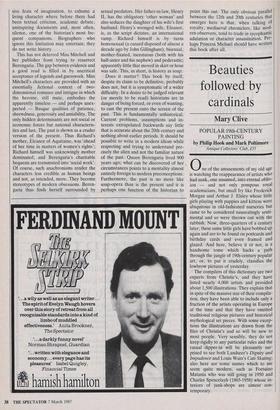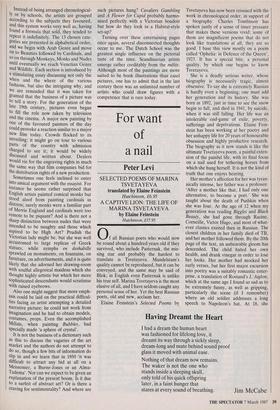Beauties followed by cardinals
Mary Clive
POPULAR 19th-CENTURY PAINTING by Philip Hook and Mark Poltimore
Antique Collectors' Club, £35
0 ne of the amusements of my old age is watching the reappearance of artists who had sunk, one assumed, into eternal obliv- ion — and not only pompous royal academicians, but small fry like Frederick Morgan and Arthur J. Elsley whose little girls playing with puppies and kittens were ubiquitous in old-fashioned nurseries but came to be considered nauseatingly senti- mental and so were thrown out with the rubbish. Now, three-quarters of a century later, these same little girls have bobbed up again and are to be found on postcards and birthday cards and even framed and glazed. And here, believe it or not, is a handsome tome which hacks a path through the jungle of 19th-century popular art, or, to put it crudely, classifies the lowbrow pictures of yesterday.
The compilers of this dictionary are two experts from Christie's, and they have listed nearly 4,000 artists and provided about 1,500 illustrations: They explain that in spite of the massive size of their compila- tion, they have been able to include only a fraction of the artists operating in Europe at the time and that they have omitted traditional religious pictures and historical mythological set pieces. With some excep- tions the illustrations are drawn from the files of Christie's and so will be new to most people. Very sensibly, they do not keep rigidly to any particular rules and the casual dipper-in will be pleasantly sur- prised to see both Landseer's Dignity and Impudence and Louis Wain's Cats Skating; also here are some names which to me seem quite modern, such as Fortuino Matania who was still going in 1950 and Charles Spencelayh (1865-1958) whose in- teriors of junk-shops are almost con- temporary. Instead of being arranged chronological- ly or by schools, the artists are grouped according to the subjects they favoured, and this system works very well as, having found a formula that sold, they tended to repeat it indefinitely. The 13 chosen cate- gories are presented in alphabetical order, and we begin with Arab Genre and move on to Beauties followed by Cardinals, and so on through Monkeys, Monks and Nudes until eventually we reach Venetian Genre and Wildlife. Each section is introduced by a stimulating essay discussing not only the when and the where of the various fashions, but also the intriguing why, and we are reminded that it was taken for granted that the business of a picture was to tell a story. For the generation of the late 19th century, pictures even began to fill the role now taken by television and the cinema. A major new painting by one of the favoured painters of the day could provoke a reaction similar to a major new film today. Crowds flocked to its unveiling; it might go on tour to various parts of the country with admission charged to see it; it would be widely discussed and written about. Dealers would vie for the engraving rights in much the same way that film companies bid for the distribution rights of a new production. Sometimes one feels inclined to enter into amical argument with the essayist. For instance he seems rather surprised that English artists painted comical monks but stood aloof from painting cardinals in distress; surely monks were a familiar part of Merrie England and cardinals were too remote to be piquant? And is there not a sharp distinction between nudes that were intended to be naughty and those which aspired to be High Art? Prudish the Victorian lady might be, but she was well accustomed to large replicas of Greek statues, while nymphs en deshabille sprawled on monuments, on fountains, on furniture, on advertisements, and it is quite likely that she adorned her drawing-room with soulful allegorical maidens which she thought highly artistic but which her more sophisticated descendants would scrutinise with raised eyebrows.
Also one might suggest that more emph- asis could be laid on the practical difficul- ties facing an artist attempting a detailed narrative picture; he could not work from imagination and he had to obtain models, costumes, props. Even the accomplished Millais, when painting Bubbles, had specially made 'a sphere of crystal'.
It is not the business of a dictionary such as this to discuss the vagaries of the art market and the authors do not attempt to do so, though a few bits of information do slip in and we learn that in 1950 'it was difficult to attract any bid at all on a Meissonier, a Burne-Jones or an Alma- Tadema'. Nor can we expect to be given an explanation of the present boom. Is it due to a surfeit of abstract art? Or is there a craving for sentimentality? And where are such pictures hung? Cavaliers Gambling and A Flower for Cupid probably harmo- nised perfectly with a Victorian boudoir but how do they look in a Habitat-style set-up?
Turning over these entertaining pages once again, several disconnected thoughts occur to me. The Dutch School was the greatest single influence on the pictorial taste of the time. Scandinavian artists emerge rather creditably from the mêlée. Although most of the paintings are more suited to be book illustrations than easel pictures, one has to admit that in the last century there was an unlimited number of artists who could draw figures with a competence that is rare today.



























































 Previous page
Previous page